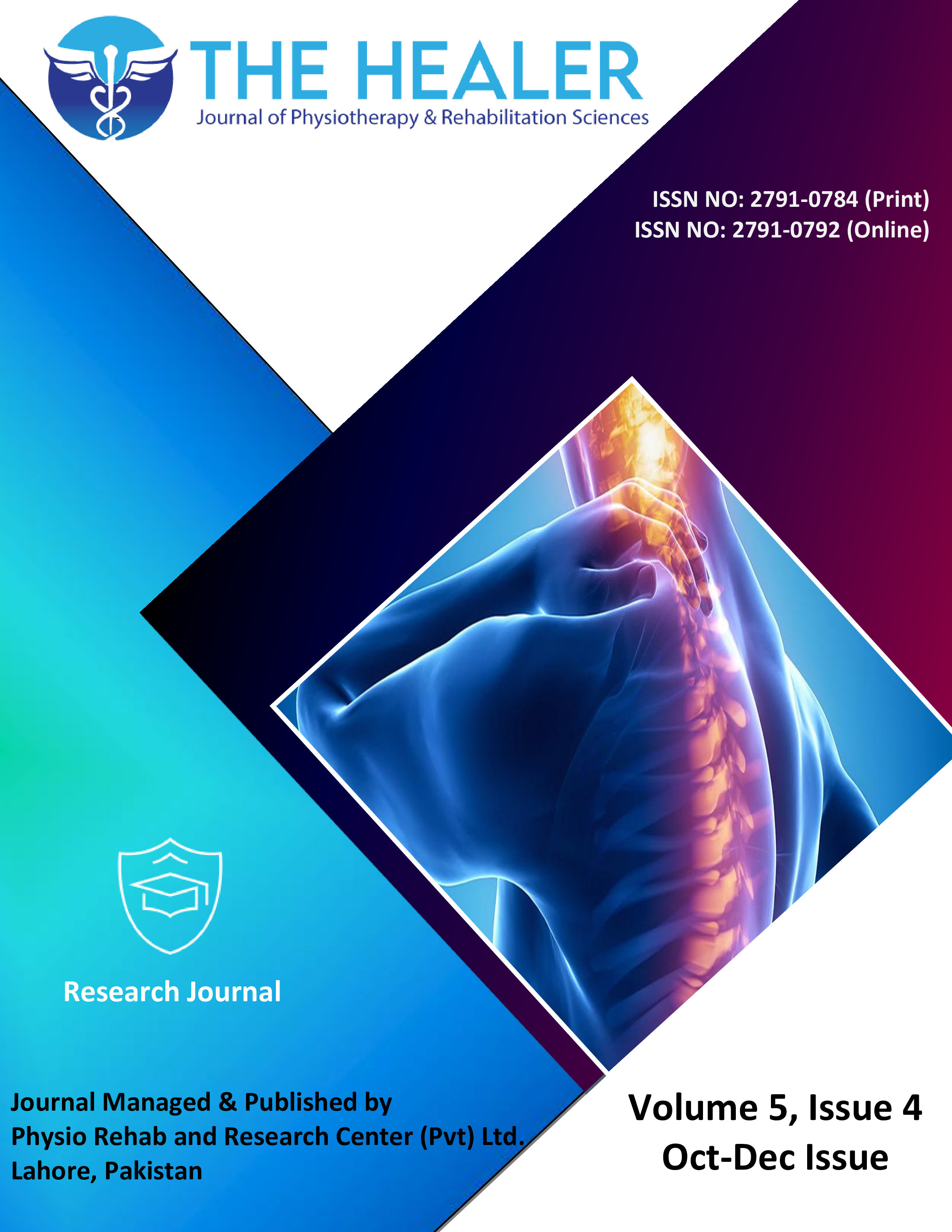Association of Prolonged Smartphone Use with Neck Posture, Pain, and Functional Disability in Young Adults
DOI:
https://doi.org/10.55735/cx5f6y23Keywords:
Bubble inclinometer , Forward head posture , Functional disability , Neck pain , Text neck syndromeAbstract
Background: In the contemporary digital era, smartphones have become indispensable tools for communication, education, and entertainment. However, their excessive and prolonged use has given rise to behavioral dependency, particularly among students and young adults who are frequent users. Extended use of smartphones often involves maintaining forward head or flexed neck postures, which may gradually lead to musculoskeletal strain, posture alterations, and functional limitations. Objective: To examine the association between prolonged smartphone use and its impact on neck posture, pain intensity, and functional disability among young adults. Methodology: This analytical cross-sectional study was conducted from March to August 2025 at the Department of Rehabilitation Sciences, Shifa Tameer-e-Millat University, Islamabad. A sample of 400 participants was enrolled utilizing a non-probability purposive sampling. Eligible participants were healthy males and females aged 18 to 25 years. Patients with a history of cervical trauma, fractures, or any neurological or vascular pathology were excluded. Ethical clearance for the study protocol was secured from the Institutional Review Board and Ethics Committee of Shifa International Hospital. The primary outcome measures included cervical range of motion, the Numeric Pain Rating Scale for pain intensity, the Neck Disability Index for functional status, and the Occiput-to-Wall Distance test for posture. Participants self-reported their average daily smartphone usage duration. Postural assessment was conducted via the Occiput-to-Wall Distance test, while cervical range of motion was evaluated using a bubble inclinometer. The pain score and Neck Disability Index were employed to quantify neck pain and its impact on daily activities, respectively. For statistical analysis, Spearman's correlation test was applied. Results: The findings revealed a weak but statistically significant positive correlation between smartphone use and both neck posture (p=0.01, r=0.11) and functional disability (p=0.00, r=0.13). However, no significant association was found with neck pain intensity (p=0.31, r=0.05). Conclusion: The study underscores that extended smartphone use is associated with postural deviations and functional impairment of the neck, though its direct link to neck pain remains statistically inconclusive. These findings highlight the need for awareness and preventive strategies to mitigate posture-related complications among young adults.
Downloads
References
1. Othman SQ, Sabr BN. Association between electronic device use and neck pain among students at the College of Education, Shaqlawa. Asian Journal of Advanced Research and Reports 2025; 19(6): 491–506.
https://doi.org/10.9734/ajarr/2025/v19i61074 DOI: https://doi.org/10.9734/ajarr/2025/v19i61074
2. Yildirim C, Correia A-P. Exploring the dimensions of nomophobia: Development and validation of a self-reported questionnaire. Computers in Human Behavior 2015; 49: 130–7.
https://doi.org/10.1016/j.chb.2015.02.059 DOI: https://doi.org/10.1016/j.chb.2015.02.059
3. Yoon W, Choi S, Han H, Shin G. Neck muscular load when using a smartphone while sitting, standing, and walking. Human Factors 2020; 63(5): 868–79.
https://doi.org/10.1177/0018720820904237 DOI: https://doi.org/10.1177/0018720820904237
4. Hansraj K. Assessment of stresses in the cervical spine caused by posture and position of the head. Surgical Technology International 2014; 25: 277–9.
5. Smith DL, Haug MJ, Walsh MS. The effect of posture on neck proprioception and head/neck stabilization in asymptomatic participants. Journal of the Canadian Chiropractic Association 2019; 63(2): 100-110.
6. Okereke IA-O, Mmerem K, Balasubramanian D. The management of cervical spine injuries - a literature review. Orthopedic Research and Reviews 2021; 13: 151-162
https://doi.org/10.2147/ORR.S324622 DOI: https://doi.org/10.2147/ORR.S324622
7. Tsantili AR, Chrysikos D, Troupis T. Text neck syndrome: disentangling a new epidemic. Acta Medica Academica 2022; 51(2): 123-127.
https://doi.org/10.5644/ama2006-124.380 DOI: https://doi.org/10.5644/ama2006-124.380
8. Lee HJ, Jeon DG, Park JH. Correlation between kinematic sagittal parameters of the cervical lordosis or head posture and disc degeneration in patients with posterior neck pain. Open Medicine 2021; 16(1): 161-168.
https://doi.org/10.1515/med-2021-0219 DOI: https://doi.org/10.1515/med-2021-0219
9. Nambirajan MK, Vidusha K, Kailasam JG, et al. Association between smartphone addiction and sedentary behaviour amongst children, adolescents and young adults: A Systematic Review and meta-analysis. Journal of Psychiatric Research 2025; 184(21): 128–39.
https://doi.org/10.1016/j.jpsychires.2025.02.049 DOI: https://doi.org/10.1016/j.jpsychires.2025.02.049
10. Mustafaoglu R, Yasaci Z, Zirek E, Griffiths MD, Ozdincler AR. The relationship between smartphone addiction and musculoskeletal pain prevalence among the young population: a cross-sectional study. The Korean Journal of Pain 2021; 34(1): 72–81.
https://doi.org/10.3344/kjp.2021.34.1.72 DOI: https://doi.org/10.3344/kjp.2021.34.1.72
11. Saeed A, Shahed A, Liaqat M, et al. Prevalence of forward head posture and its association with smartphone use among university students: prevalence of forward head posture and association with smartphone use. Pakistan BioMedical Journal 2024; 7(10): 13–18.
https://doi.org/10.54393/pbmj.v7i10.1141 DOI: https://doi.org/10.54393/pbmj.v7i10.1141
12. Sirajudeen MS, Alzhrani M, Alanazi A, et al. Prevalence of text neck posture, smartphone addiction, and its association with neck disorders among university students in the Kingdom of Saudi Arabia during the COVID-19 pandemic. PeerJ 2022; 10: e14443.
https://doi.org/10.7717/peerj.14443 DOI: https://doi.org/10.7717/peerj.14443
13. Chen Y-J, Hu C-Y, Wu W-T, et al. Association of smartphone overuse and neck pain: a systematic review and meta-analysis. Postgraduate Medical Journal 2025; 101(1197): 620–6.
https://doi.org/10.1093/postmj/qgae200 DOI: https://doi.org/10.1093/postmj/qgae200
14. Hakami I, Sherwani A, Hadadi M, et al. Assessing the Impact of Smartphone Use on Neck Pain and Related Symptoms Among Residents in Jeddah, Saudi Arabia: A Cross-Sectional Study. Cureus 2024; 16(7): e64299.
https://doi.org/10.7759/cureus.64299 DOI: https://doi.org/10.7759/cureus.64299
15. Maayah MA-O, Nawasreh ZH, Gaowgzeh RAM, Neamatallah Z, Alfawaz SS, Alabasi UM. Neck pain associated with smartphone usage among university students. PLoS One 2023; 18(6): e0285451.
https://doi.org/10.1371/journal.pone.0285451 DOI: https://doi.org/10.1371/journal.pone.0285451
16. Kim MS. Influence of neck pain on cervical movement in the sagittal plane during smartphone use. Journal of Physical Therapy Science 2015; 27(1): 15-7.
https://doi.org/10.1589/jpts.27.15 DOI: https://doi.org/10.1589/jpts.27.15
17. Bertozzi L, Negrini S, Agosto D, et al. Posture and time spent using a smartphone are not correlated with neck pain and disability in young adults: A cross-sectional study. Journal of Bodywork and Movement Therapies 2021; 26: 220-226.
https://doi.org/10.1016/j.jbmt.2020.09.006 DOI: https://doi.org/10.1016/j.jbmt.2020.09.006
18. Ramalingam V, Subramaniam A. Prevalence and Associated Risk Factors of Forward Head Posture among University Students. Indian Journal of Public Health Research & Development 2019; 10(7): 775.
https://doi.org/10.5958/0976-5506.2019.01669.3 DOI: https://doi.org/10.5958/0976-5506.2019.01669.3
19. Bashir U, Noor R, Shoukat H, Ali ML, Javed MT, Hassan Z. Correlation of mobile phone usage on grip strength, disabilities and posture in young adults. The Rehabilitation Journal 2023; 7(1): 495–8.
https://doi.org/10.52567/trj.v7i01.210 DOI: https://doi.org/10.52567/trj.v7i01.210

Downloads
Published
License
Copyright (c) 2025 The Healer Journal of Physiotherapy and Rehabilitation Sciences

This work is licensed under a Creative Commons Attribution 4.0 International License.














